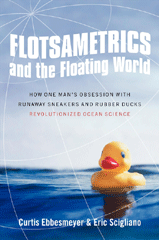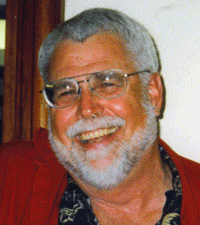The Floating World
Air Date: Week of May 1, 2009

In 1990, Nike sneakers mysteriously washed up all along the Pacific Coast. These floating shoes were the beginning of a life’s work for oceanographer Curtis Ebbesmeyer. He has spent the years since then tracking everything from sneakers to rubber ducks that float on the ocean’s surface – and learning the deeper workings of the seas in the process. Ebbesmeyer joins host Jeff Young to talk about his new book, "Flotsametrics and the Floating World."
Transcript
YOUNG: Well it’s nearly time for many of us to plan a trip to the beach—maybe dig some of those clams, as we catch some rays, or do a bit of beachcombing.
Oceanographer Curtis Ebbesmeyer has turned beachcombing into a lifetime scientific pursuit. From Nike shoes to rubber duckies – to the proverbial message in a bottle – he’s studied the stuff that floats on the sea. And it’s led him to a deeper understanding of how our oceans really work.
Ebbesmeyer’s just written a book called “Flotsametrics and the Floating World” – and he joins us now from Seattle – welcome to Living on Earth!
EBBERMEYER: It’s a pleasure, Jeff. Thank you for having me.
YOUNG: How did you get started in this? Why follow floating junk on the ocean?
EBBERMEYER: Well, I started by following slabs of water back in the 60s and following currents in the water is like chasing ghosts, you can’t really see them except with electronical things and instruments. And then in about 1990 my mom pointed out all these Nike sneakers washing on the ocean and she said, “isn’t that what you do?” I’ve never looked back.
YOUNG: So tell me about the sneakers that went over board – how did that happen anyway?

Curtis Ebbesmeyer.
YOUNG: But they had to find the other one, right?
EBBESMEYER: So they were having swap meets up and down the coast, exactly.
YOUNG: To match the left with the right?
EBBERMEYER: Exactly.
[LAUGHING]
EBBESMEYER: A friend of my Steve McLeod had been making matches and he was selling them for $30 a pair, a matched pair and he had records of 1600. And it turned out that each Nike shoe and an individual number, which I could trace like a message in a bottle. So I learned where they went, where they fell overboard and I learned where they washed up out of the ocean.
YOUNG: So, from there you’ve really kind of tapped in to beachcombers, scavengers as your first wave of scientists, of data collectors.
EBBESMEYER: Exactly, there’s armies of beachcombers out there every day collecting things and they until now had been outside of science, so I guess it’d be like archeologists ignoring the people who find potshards in the fields.
YOUNG: You know something I love about the Nike sneaker story is so many of them washed up really close to the Nike headquarters. It was almost like they were salmon returning to the ancestral spawning ground or something.
[LAUGHING]
EBBESMEYER: I tried to point that out to Nike but they said – I said don’t you want to use this for some kind of advertising value. They said quote “floating on the ocean is not a sports attribute that we wish to endorse.”
[LAUGHING]
YOUNG: Right
EBBESMEYER: Unquote.
YOUNG: Another big spill of cargo that you found especially intriguing – it was these rubber duckies.
EBBESMEYER: Yeah, that was in the 1990s, about every year or two they’d be a cargo container or so go over board with some really interesting flotsam. 1990 was the year of the Nike sneakers. 1992 was the year of the bathtub toys. One cargo container that went overboard held 29,000 turtles, ducks, beavers, and frogs. And I learned point A and beachcombers were reporting all kinds of points B around Sitka.
YOUNG: Sitka, in Alaska.
EBBESMEYER: Correct.
YOUNG: And why did they go there?
EBBESMEYER: They wrote the southern edge of the Aleut gyre. It’s that great circle of currents. It runs from Sitka over to Kamchatka down to Japan and back to Sitka again. It’s about an 8,000-mile circuit. And it takes about three years to go around and every time the toys would do around that gyre one orbit, you’d see more of them at Sitka. And it’s just almost like clockwork. Quite amazing. So I learned that that gyre was a three-year orbital period and I started collecting flotsam for the ten other gyres in the planet. And they have this wonderful sequence in octaves – thirteen years, six years, three years, and one and a half years. So the ocean has this grand musical scale, which I’m still in awe of.
YOUNG: What importance have these gyres had for humans?
EBBESMEYER: They’ve actually influenced the course of history in remarkable ways that hasn’t heretofore been appreciated. Columbus saw flotsam in the Azores, which he thought was remarkably fresh and reported that to the Queen, saying that land can’t be too far to the west. So flotsam had a significant bearing on Columbus going to the Americas. The Vikings knew where things collected. Their God Thor told them – commanded them actually – to put treasured heirlooms on the water as they approached Iceland on the southeast shore and wherever those heirlooms washed up Thor commanded them to built their home. And its actually very practical oceanography because the heirlooms were mostly wood, and wood will drift like other wood and find collections spots where there is plenty of drift wood for fire, for building homes and so forth. So it was a very practical way of finding a great place for a new home.
YOUNG: What does all this tell us about larger environmental issues and the oceans?
EBBESMEYER: Well probably the largest one has to do with what the flotsam is made of. And these days most flotsam is made of plastic. Charlie Moore has taken up this great crusade and he’s actually out here sampling what’s at the surface. In one of the great spots of the ocean where things collect he found six times more plastic than plankton at the base of the food chain. So, it’s pretty horrific, we’re actually infecting the lifeblood of the planet. 10,000 years from now we’re gonna have oceanographers and they like to core out through the sentiments in the bottom of the ocean, and they’re going to come across a layer of plastic. And they’re going to say, “we’ve found them, we’ve found them, we’ve finally found the plastic people with that killed our planet.”

YOUNG: Oh my goodness. The plastic people. Is that how we’re going to be known do you think?
EBBESMEYER: If we don’t clean up our act, we’ll be known as the plastic people and we’ll be a thin layer in the sedimentary rocks.
YOUNG: Do you have a favorite piece of flotsam - something that you’ve found on the beach that you think is the all time best?
EBBESMEYER: All time best? Well, I do – I have favorite flotsam. I’m always collecting armies. There’s an army on the ocean – little toys soldiers – I collect incredible numbers of toy armies, so I always think of the military on the ocean in terms of this giant toy armada. And I like to collect little toy wheels because they remind me of the great gyres that cover forty percent of our planet.
YOUNG: The book is called “Flotsametrics and the Floating World.” And we’ve been talking with Curtis Ebbesmeyer. Thank you so much for being with us.
EBBESMEYER: Jeff, it’s been a real pleasure. Thanks a lot.
[KJ Denhert “Message In A Bottle” from Dal Vivo A Umbria Jazz (Motema Records 2008)]
Links
Living on Earth wants to hear from you!
Living on Earth
62 Calef Highway, Suite 212
Lee, NH 03861
Telephone: 617-287-4121
E-mail: comments@loe.org
Newsletter [Click here]
Donate to Living on Earth!
Living on Earth is an independent media program and relies entirely on contributions from listeners and institutions supporting public service. Please donate now to preserve an independent environmental voice.
NewsletterLiving on Earth offers a weekly delivery of the show's rundown to your mailbox. Sign up for our newsletter today!
 Sailors For The Sea: Be the change you want to sea.
Sailors For The Sea: Be the change you want to sea.
 The Grantham Foundation for the Protection of the Environment: Committed to protecting and improving the health of the global environment.
The Grantham Foundation for the Protection of the Environment: Committed to protecting and improving the health of the global environment.
 Contribute to Living on Earth and receive, as our gift to you, an archival print of one of Mark Seth Lender's extraordinary wildlife photographs. Follow the link to see Mark's current collection of photographs.
Contribute to Living on Earth and receive, as our gift to you, an archival print of one of Mark Seth Lender's extraordinary wildlife photographs. Follow the link to see Mark's current collection of photographs.
 Buy a signed copy of Mark Seth Lender's book Smeagull the Seagull & support Living on Earth
Buy a signed copy of Mark Seth Lender's book Smeagull the Seagull & support Living on Earth

